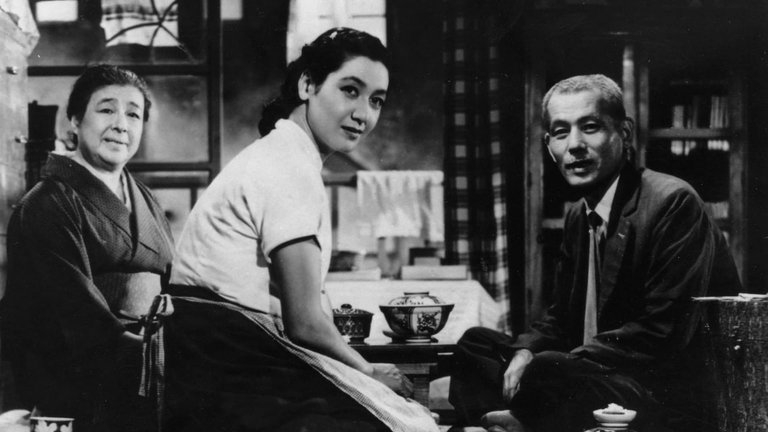Film Review: Tokyo Story (1953)

Japanese cinema is in popular perception associated with distinctly Japanese genres such as anime, "jidai-geki," or "kaiju" films. However, in the eyes of critics and film scholars alike, the most esteemed and widely revered Japanese film belongs to more generic and universal genre. It is none other than Tokyo Story, a 1953 drama directed by Yasujiro Ozu.
The plot revolves around an elderly couple, Shukichi Hirayama (played by Chishu Ryu) and his wife Tomi Hirayama (played by Chieko Higashiyama), who, together with their youngest daughter Kyoko (played by Kyoko Kagawa) reside in Onomichi, a port city situated in western Japan. Spouses decide to visit their other children residing in Tokyo. These include son Koichi (played by So Yamamura), a physician running a small clinic in the suburbs; Shige (played by Haruko Sugimura), the owner of a hairdressing salon; and Noriko (played by Setsuko Hara), wife of their missing son Shoji who disappeared during World War II and is presumed dead. As they arrive in the bustling metropolis, they soon discover that Koichi and Shige are too engrossed in their work and daily family lives to offer them any meaningful attention. Conversely, Noriko views her parents-in-law as the last remaining link to her husband she never properly mourned. Shige, seeking a solution to this predicament, opts to send his parents to the seaside spa town of Atami. However, the elderly Hirayamas find the hotel, teeming with boisterous young people, utterly unappealing and subsequently return to Tokyo. Amidst this turmoil, Tomi begins to manifest signs of illness.
Tokyo Story isn't exactly an original film; Kogo Noda, who co-authored the script with Ozu, had found the basic idea for the plot in Make Way for Tomorrow, a 1937 Classic Hollywood drama directed by Leo McCarey. Due to similarities in plot and characters, Tokyo Story is sometimes considered its unofficial remake. However, there are significant differences, mainly in the script, which does not set the story in America during the Great Depression nor deal with economic issues as much as it explores the cultural differences between generations that began to emerge following Japan's defeat in World War II.
Ozu, unlike Kurosawa, is considered an "old school" Japanese filmmaker who, like most of his associates, began his career in the silent era. He is also considered an "acquired taste" because his style, based on static shots, not only looks old-fashioned but also tends to make plots unfold in a very slow manner. This makes Tokyo Story more than two hours long, which might deter some viewers.
Nevertheless, much of the heavy lifting in the film is carried by an experienced and very talented cast. Chishu Ryu, who appeared in 52 out of 54 Ozu's films, plays the role of stoical Shukichi with great skill, easily winning audience's sympathy with grandfatherly gravitas and maintains that sympathy even when his character briefly relapses into alcoholism after accidentally meeting old friends in Tokyo. The same can be said of Chieko Higashiyama in the role of his saintly wife. However, it is Setsuko Hara who gives the most memorable impression, playing a woman torn between her desire to cling to the past and the more sensible option of moving on.
Ozu's style, on the other hand, allows more patient and perceptive viewers to notice not only very good characterisation and subtle drama but also many details about Japan seven decades ago. The country depicted has mostly recovered from the war, but the Japanese Economic Miracle still hasn't manifested itself. Tokyo, as depicted in this film, isn't a futuristic metropolis with bright neon lights; instead, it's a place where technology is still analogue rather than digital, and where people live in cramped little apartments with tension being exacerbated by intense summer heat. Ozu makes a visual contrast between the mostly claustrophobic Tokyo and more open spaces of Hirayama's home in less urban Onomichi.
Tokyo Story was, despite being a black-and-white drama, a commercial success. However, Shochiku, the grand Japanese film studio for which Ozu had worked from the 1920s, originally refused to distribute it abroad, considering its themes and characters "too Japanese" to be understood by foreign viewers. When the film finally appeared in Western cinemas, it was greeted enthusiastically by critics and its reputation grew through the years, making it a coveted Top Ten spot at prestigious Sight & Sound poll.
Tokyo Story, despite its style that might look old fashioned, offers an interesting, and at times, powerful exploration of issues of ageing, mortality and shifting dynamics in family relations. As such, it could be recommended to cinephiles as Ozu’s and Japan’s vital contribution to the world's cinematic heritage.
RATING: 7/10 (+++)
Blog in Croatian https://draxblog.com
Blog in English https://draxreview.wordpress.com/
InLeo blog https://inleo.io/@drax.leo
Hiveonboard: https://hiveonboard.com?ref=drax
Rising Star game: https://www.risingstargame.com?referrer=drax
1Inch: https://1inch.exchange/#/r/0x83823d8CCB74F828148258BB4457642124b1328e
BTC donations: 1EWxiMiP6iiG9rger3NuUSd6HByaxQWafG
ETH donations: 0xB305F144323b99e6f8b1d66f5D7DE78B498C32A7
BCH donations: qpvxw0jax79lhmvlgcldkzpqanf03r9cjv8y6gtmk9
Posted Using InLeo Alpha